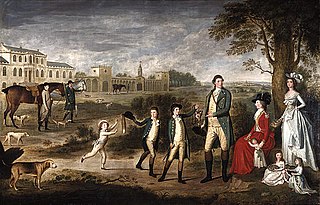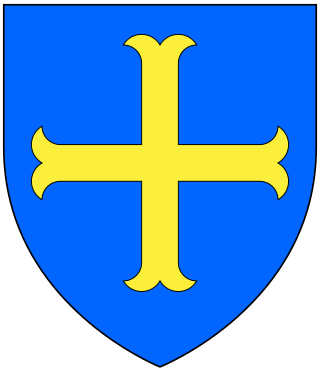
Marquess of Aberdeen and Temair, in the County of Aberdeen, in the County of Meath and in the County of Argyll, is a title in the Peerage of the United Kingdom. It was created on 4 January 1916 for John Hamilton-Gordon, 7th Earl of Aberdeen.
James Hamilton, 1st Earl of AbercornPC (S) (1575–1618) was a Scottish diplomat for James VI and an undertaker in the Plantation of Ulster, Ireland.

The title Duke of Abercorn is a title in the Peerage of Ireland. It was created in 1868 and bestowed upon James Hamilton, 2nd Marquess of Abercorn. Although the Dukedom is in the Peerage of Ireland, it refers to Abercorn, West Lothian, and the Duke also bears four titles in the Peerage of Scotland and two in the Peerage of Great Britain, and is one of only three peers who have titles in those three peerages. The Duke of Abercorn also claims the French title of Duke of Châtellerault, created in 1548.

James Albert Edward Hamilton, 3rd Duke of Abercorn, styled Marquess of Hamilton between 1885 and 1913, was a British peer and Unionist politician. He was the first Governor of Northern Ireland, a post he held between 1922 and 1945. He was a great-grandfather of Diana, Princess of Wales.
There have been three baronetcies created for members of the Anstruther family, two in the Baronetage of Nova Scotia and one in the Baronetage of Great Britain. Two of the creations are extant while one is extinct.
James Hamilton, 2nd Earl of Abercorn was a Catholic Scottish nobleman. He, his wife, his mother, and most of his family were persecuted by the kirk as recusants. Implementing his father's will, he gave his Irish title of Baron Hamilton of Strabane to his younger brother Claud. His younger brothers inherited his father's Irish lands, while he received the Scottish ones, which he squandered away, being deep in debt in his later days.

There have been six baronetcies created for persons with the surname Smyth, two in the Baronetage of England, one in the Baronetage of Great Britain, one in the Baronetage of Ireland and two in the Baronetage of the United Kingdom. One creation is extant as of 2010.
There have been several baronetcies created for people with the surname Dalrymple.
Claud Hamilton, 2nd Baron Hamilton of Strabane was the founder of the Strabane branch of the Hamiltons. He died relatively young at about 32 and his wife, Jean Gordon, married Sir Phelim O'Neill, one of the leaders of the 1641 rebellion, after his death.
Charles Hamilton, 5th Earl of Abercorn succeeded his brother who had been attainted as a Jacobite and, having conformed to the established religion, could get the attainder reversed.

James Hamilton, 6th Earl of Abercorn, PC (Ire), was a Scottish and Irish peer and politician. Appointed a groom of the bedchamber to Charles II after his father's death in battle, he took the Williamite side at the Glorious Revolution and in March 1689 supplied Derry with stores that enabled the town to sustain the Siege of Derry until it was relieved in August. Shortly after inheriting a Scottish and Irish peerage from a second cousin, he was created a viscount in Ireland for his services to the Williamite cause.

James Hamilton, 7th Earl of AbercornPC (Ire) (1686–1744), styled Lord Paisley from 1701 to 1734, was a Scottish and Irish nobleman and peer. An amateur scientist and musician, he published a book on magnetism in 1729 and a treatise on musical harmony in 1730, which was subsequently emended and re-issued by his teacher, Dr. Pepusch.
Sir George Hamilton, 1st Baronet of Donalong and Nenagh, was born in Scotland, but inherited land in Ireland. Despite being Catholic, he served his Protestant brother-in-law, the 1st Duke of Ormond, lord lieutenant of Ireland, in diplomatic missions during the Confederate Wars and as receiver-general of the royalists. He also defended Nenagh Castle against the Parliamentarians during the Cromwellian conquest of Ireland. Hamilton was father of Anthony, author of the Mémoires du Comte de Grammont, of Richard, Jacobite general, and of Elizabeth, "la belle Hamilton".

There have been five baronetcies of the United Kingdom created for a person with the surname Erskine, two in the Baronetage of Nova Scotia, one in the Baronetage of Great Britain and two in the Baronetage of the United Kingdom. Two of the creations are extant as of 2010.

There have been two baronetcies created for people with the surname Tollemache, or Talmash, one in the Baronetage of England and one in the Baronetage of Great Britain.

The Hales Baronetcy, is a title in the Baronetage of England. There were three Hales baronetcies. The oldest was created in 1611 for Edward Hales. He was a member of a Kent family. The second was created in 1660 for Robert Hales, MP for Hythe 1659, also of a Kent family. The third was created in 1660 for John Hales of Coventry, co. Warwick.
There have been three baronetcies created for persons with the surname Noel, two in the Baronetage of England and one in the Baronetage of Great Britain. One creation is extant as of 2008.

There have been three baronetcies created for descendants of the ancient Norman family of Molyneux who were granted extensive estates in Lancashire after the Norman Conquest.

Earl of Arran is a title in the Peerage of Ireland. It is not to be confused with the title Earl of Arran in the Peerage of Scotland. The two titles refer to different places: the Aran Islands in Ireland, and the Isle of Arran in Scotland. The Irish earldom is held by the Gore family. The Scottish earldom is a separate title, held as a subsidiary title of the Duke of Hamilton.

The Hamilton baronetcy, of Silvertonhill in the County of Lanark, was created in the Baronetage of Nova Scotia in 1646 for Robert Hamilton, a Royalist and favourite of Charles I. He was a descendant of Alexander Hamilton of Silvertonhill, brother of James Hamilton, 1st Lord Hamilton.











